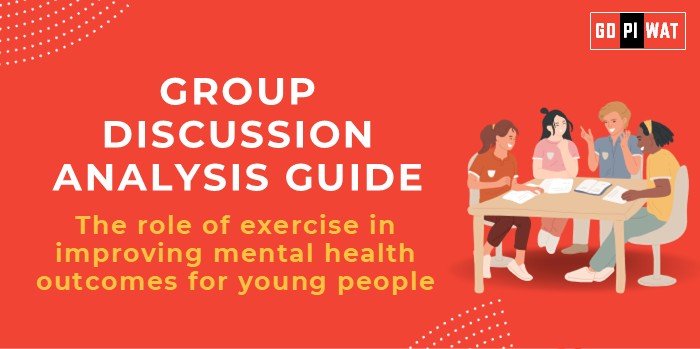📋 Group Discussion (GD) Analysis Guide: The Role of Exercise in Improving Mental Health Outcomes for Young People
🌐 Introduction to “The Role of Exercise in Improving Mental Health Outcomes for Young People”
Opening Context:
“With rising mental health concerns among the youth globally, exercise has emerged as a vital, non-invasive tool to enhance mental well-being. Its role has garnered attention from psychologists, educators, and policymakers alike.”
Topic Background:
Exercise is increasingly recognized for its dual benefits of physical health and mental wellness. Research highlights its ability to alleviate symptoms of anxiety, depression, and stress, especially among young individuals, who often face intense academic and societal pressures.
📊 Quick Facts and Key Statistics
- 🌍 Youth Depression Rates: 15% of young people globally experience depression annually (WHO, 2023).
- 🏃♂️ Impact of Exercise: Studies show a 30% reduction in depressive symptoms with regular physical activity.
- 📏 Activity Guidelines: WHO recommends 60 minutes of daily physical activity for mental and physical health benefits in adolescents.
- 💰 Economic Cost: Mental health issues cost $1 trillion in global productivity annually, part of which could be mitigated by exercise interventions.
👥 Stakeholders and Their Roles
- 🏛️ Government Bodies: Promote exercise through school curriculums and public health campaigns.
- 🏫 Educational Institutions: Provide infrastructure and time for physical activities.
- 🩺 Health Professionals: Advocate for exercise in therapeutic practices.
- 🌍 NGOs and Community Groups: Create awareness programs for accessible mental health solutions.
🏆 Achievements and Challenges
✨ Achievements:
- 📚 Improved Academic Outcomes: Studies link physical fitness with higher academic performance.
- 🏘️ Community Initiatives: Programs like “Daily Mile” in the UK show enhanced mental well-being in participating schools.
- 💸 Cost-Effectiveness: Exercise programs are low-cost compared to medical interventions.
⚠️ Challenges:
- ❓ Awareness Gap: Lack of understanding about exercise’s mental health benefits.
- 🏞️ Access Disparities: Unequal availability of sports facilities in urban vs. rural settings.
- 💡 Motivational Barriers: Youth often lack motivation or support to engage in physical activity.
🌍 Global Comparisons:
- 🇦🇺 Australia: Implements “Mindful Movement” programs in schools combining exercise and mindfulness.
- 🇯🇵 Japan: Integrates exercise into daily routines for students, showing reduced stress levels.
📚 Case Studies:
- 🇮🇳 India: “Fit India Movement” incorporates mental health benefits into fitness campaigns.
- 🇺🇸 USA: The “Active Minds” initiative links fitness programs with mental health support networks.
💬 Structured Arguments for Discussion
- ✔️ Supporting Stance: “Regular exercise is scientifically proven to reduce depressive symptoms by 30%, making it an essential tool for improving mental health among youth.”
- ❌ Opposing Stance: “While exercise is beneficial, it cannot replace professional mental health interventions for severe cases.”
- 🔄 Balanced Perspective: “Exercise, when paired with other mental health strategies, can significantly enhance young people’s overall well-being.”
🎯 Effective Discussion Approaches
🚀 Opening Approaches:
- 📊 Statistical Insight: “15% of youth globally experience depression annually; could regular exercise reduce this staggering figure?”
- 📚 Case Study Example: “Programs like the ‘Daily Mile’ in UK schools show how exercise can transform mental well-being.”
- ⚖️ Contrast Technique: “Despite exercise’s benefits, mental health issues persist among youth—how can we bridge this gap?”
💡 Counter-Argument Handling:
- ✔️ Acknowledge Limitations: “Agreed, lack of infrastructure and motivation are challenges…”
- 🔧 Suggest Solutions: “…but integrating exercise with therapy and leveraging community programs can make a difference.”
- 🌍 Use Global Examples: Highlight Japan’s integrated school programs or Australia’s “Mindful Movement.”
🔍 Strategic Analysis of Strengths and Weaknesses
- 💪 Strengths: Scientifically backed benefits, low-cost intervention, improves both mental and physical health.
- ⚖️ Weaknesses: Limited outreach in rural areas, misconceptions about its effectiveness.
- 🌱 Opportunities: Integration into school curricula, partnerships with health professionals.
- ⚠️ Threats: Over-reliance as a sole solution, societal neglect of mental health issues.
🎓 Connecting with B-School Applications
🌐 Real-World Applications:
- 📈 Designing corporate wellness programs.
- 📊 Studying behavioral economics in public health.
🤔 Sample Interview Questions:
- ❓ “How can exercise programs be tailored for better mental health outcomes in underserved communities?”
- ❓ “Evaluate the role of government policies in promoting youth fitness.”
💡 Insights for B-School Students:
- 🔍 Explore wellness-based management strategies.
- 📊 Consider exercise as part of sustainable healthcare innovations.


